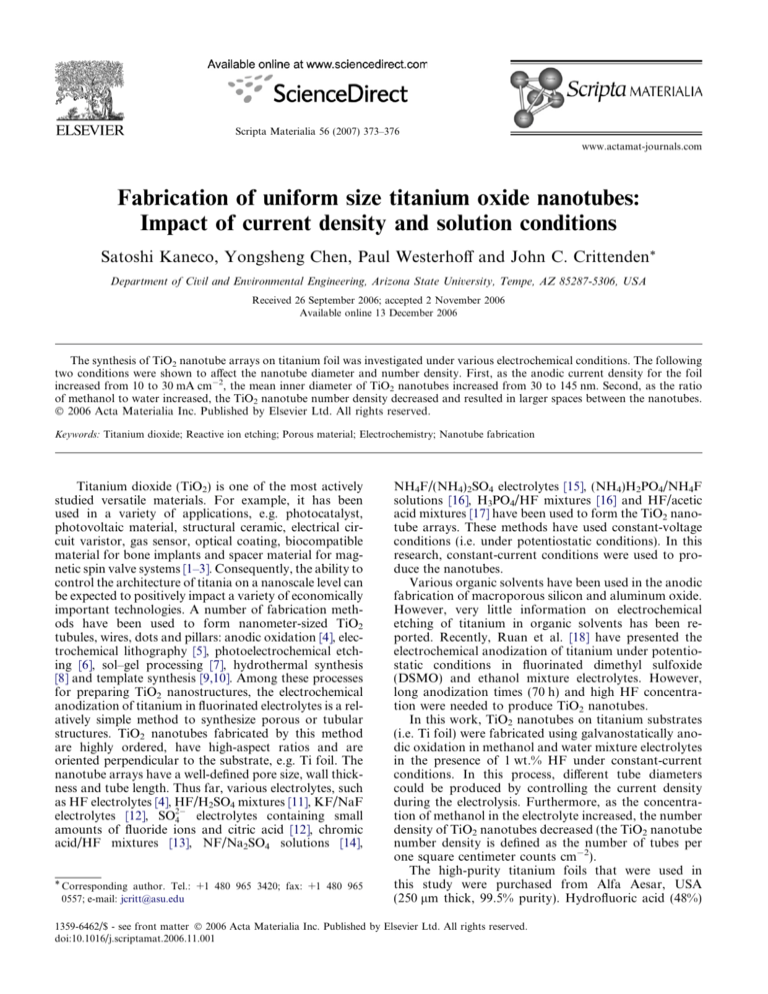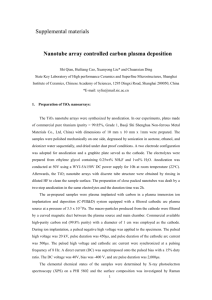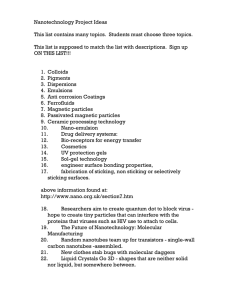
Scripta Materialia 56 (2007) 373–376
www.actamat-journals.com
Fabrication of uniform size titanium oxide nanotubes:
Impact of current density and solution conditions
Satoshi Kaneco, Yongsheng Chen, Paul Westerhoff and John C. Crittenden*
Department of Civil and Environmental Engineering, Arizona State University, Tempe, AZ 85287-5306, USA
Received 26 September 2006; accepted 2 November 2006
Available online 13 December 2006
The synthesis of TiO2 nanotube arrays on titanium foil was investigated under various electrochemical conditions. The following
two conditions were shown to affect the nanotube diameter and number density. First, as the anodic current density for the foil
increased from 10 to 30 mA cm2, the mean inner diameter of TiO2 nanotubes increased from 30 to 145 nm. Second, as the ratio
of methanol to water increased, the TiO2 nanotube number density decreased and resulted in larger spaces between the nanotubes.
2006 Acta Materialia Inc. Published by Elsevier Ltd. All rights reserved.
Keywords: Titanium dioxide; Reactive ion etching; Porous material; Electrochemistry; Nanotube fabrication
Titanium dioxide (TiO2) is one of the most actively
studied versatile materials. For example, it has been
used in a variety of applications, e.g. photocatalyst,
photovoltaic material, structural ceramic, electrical circuit varistor, gas sensor, optical coating, biocompatible
material for bone implants and spacer material for magnetic spin valve systems [1–3]. Consequently, the ability to
control the architecture of titania on a nanoscale level can
be expected to positively impact a variety of economically
important technologies. A number of fabrication methods have been used to form nanometer-sized TiO2
tubules, wires, dots and pillars: anodic oxidation [4], electrochemical lithography [5], photoelectrochemical etching [6], sol–gel processing [7], hydrothermal synthesis
[8] and template synthesis [9,10]. Among these processes
for preparing TiO2 nanostructures, the electrochemical
anodization of titanium in fluorinated electrolytes is a relatively simple method to synthesize porous or tubular
structures. TiO2 nanotubes fabricated by this method
are highly ordered, have high-aspect ratios and are
oriented perpendicular to the substrate, e.g. Ti foil. The
nanotube arrays have a well-defined pore size, wall thickness and tube length. Thus far, various electrolytes, such
as HF electrolytes [4], HF/H2SO4 mixtures [11], KF/NaF
electrolytes containing small
electrolytes [12], SO2
4
amounts of fluoride ions and citric acid [12], chromic
acid/HF mixtures [13], NF/Na2SO4 solutions [14],
* Corresponding author. Tel.: +1 480 965 3420; fax: +1 480 965
0557; e-mail: jcritt@asu.edu
NH4F/(NH4)2SO4 electrolytes [15], (NH4)H2PO4/NH4F
solutions [16], H3PO4/HF mixtures [16] and HF/acetic
acid mixtures [17] have been used to form the TiO2 nanotube arrays. These methods have used constant-voltage
conditions (i.e. under potentiostatic conditions). In this
research, constant-current conditions were used to produce the nanotubes.
Various organic solvents have been used in the anodic
fabrication of macroporous silicon and aluminum oxide.
However, very little information on electrochemical
etching of titanium in organic solvents has been reported. Recently, Ruan et al. [18] have presented the
electrochemical anodization of titanium under potentiostatic conditions in fluorinated dimethyl sulfoxide
(DSMO) and ethanol mixture electrolytes. However,
long anodization times (70 h) and high HF concentration were needed to produce TiO2 nanotubes.
In this work, TiO2 nanotubes on titanium substrates
(i.e. Ti foil) were fabricated using galvanostatically anodic oxidation in methanol and water mixture electrolytes
in the presence of 1 wt.% HF under constant-current
conditions. In this process, different tube diameters
could be produced by controlling the current density
during the electrolysis. Furthermore, as the concentration of methanol in the electrolyte increased, the number
density of TiO2 nanotubes decreased (the TiO2 nanotube
number density is defined as the number of tubes per
one square centimeter counts cm2).
The high-purity titanium foils that were used in
this study were purchased from Alfa Aesar, USA
(250 lm thick, 99.5% purity). Hydrofluoric acid (48%)
1359-6462/$ - see front matter 2006 Acta Materialia Inc. Published by Elsevier Ltd. All rights reserved.
doi:10.1016/j.scriptamat.2006.11.001
374
S. Kaneco et al. / Scripta Materialia 56 (2007) 373–376
and methanol (99.9%) were purchased from Aldrich
Corp. (Milwaukee, WI). A fluorinated (1 wt.% HF)
methanol and water mixture electrolyte was prepared
using ultrapure water. The ultrapure water was obtained
by treating distilled water with the Nanopure Diamond
Ultrapure Water Treatment System (Barnstead Thermolyne Corporation, Dubuque, IA).
The electrochemical anodization of titanium was
galvanostatically performed using a DC power supply
(BK PRECISION, CAT.II MODEL 1715A, 0–60 V,
0–2 A, 210 W). A constant-current was maintained by
adjusting the voltage.
Prior to the electrochemical treatment, titanium foils
were polished mechanically to a mirror image. They
were then chemically degreased and etched by immersing them in methanol and 6 mol l1 nitric acid solution
for 5 and 10 min, respectively. Next, they were rinsed
with ultrapure water and dried in air at room
temperature.
All anodization experiments were carried out at room
temperature using two electrodes that were separated by
20 mm. The TiO2 nanotube arrays were prepared in a
cylindrical electrochemical reactor (60 mm diameter by
60 mm height). A titanium foil (15 · 33 · 0.25 mm)
was used as anode and a platinum foil (25 · 25 ·
0.1 mm) was used as cathode. The current density in
the cell was varied between 10 and 30 mA cm2 for
the Ti foil. The electrolysis time was set at 30 min. During the anodization, the electrolytes were stirred using a
magnetic stirrer. After the treatment, the samples were
rinsed in ultrapure water, dried at room temperature
and characterized.
The structural and morphological conditions of the
TiO2 nanotubes were characterized using an environmental field-emission scanning electron microscope
(PHILIPS FEI XL-30 SEM) operating an accelerating
voltage of 20 kV. The scanning electron microscope
was capable of energy dispersive X-ray spectroscopy
(EDX).
The literature reports the use of various electrolytes for
the fabrication of TiO2 nanotubes [4,11–20]. However,
these anodization experiments were carried out under
constant-voltage conditions (potentiostatically) and, as
a result, the current densities changed greatly during electrolysis (e.g. from 15 to 28 mA cm2 [19]). Mor et al. [20]
reported that, for a fixed HF concentration and anodization potential, the dimensions of the tube varied with
respect to voltage and HF concentration. These phenomena may suggest that current density plays a significant
role in nanotube formation with respect to pore size
and morphology. Therefore, a galvanostatic anodization
method was used in this work.
During anodization, hydrogen bubbles were produced on the cathode surface. In the aqueous solution,
these bubbles become relatively large, and remain on
the electrode surface until they have sufficient buoyancy
to break free from the surface. Unfortunately, the formation of relatively large bubbles causes a fluctuation
of the current density. However, smaller bubbles are
formed and break free from the surface when methanol
is added to the solution [21]. Consequently, methanol
was added to the electrolyte solution in this study to
reduce the hydrogen bubble size and the current density
was carefully controlled. The surface tension of water
and pure methanol at 303.15 K and atmospheric pressure are 71.40 and 21.71 mN m1, respectively [22].
Therefore, the reduced bubble size may be due to a
reduction in surface tension that results from methanol
addition to the electrolyte solution.
During anodization, the visual color of the TiO2 layer
changed from purple to blue, yellow, red and light green
during the initial 10–15 min. The visual color change
may be attributed to the increasing thickness of TiO2,
and may suggest the formation of TiO2 nanotubes.
Using EDX analysis, the approximate Ti:O atom ratio
was determined to be 1:2.
The effect of current density on the fabrication of
TiO2 nanotubes was investigated using a HF concentration of 1 wt.%, an electrolysis time of 30 min and a
methanol volume fraction of 50%. These conditions
were chosen from preliminary experiments using electrolysis times of 30–60 min, HF concentrations of
1–2 wt.% and a current density of 10 mA cm2 using
variable methanol water mixtures. Figure 1 shows
SEM images of surface structures that were obtained
with for current densities of 10–30 mA cm2. For
current densities of 10 mA cm2 (Fig. 1(a)), the inner
diameter of TiO2 nanotubes was very small, 30 nm.
As the current densities increased, the inner diameter
of the TiO2 nanotubes increased from 30 to 145 nm, as
illustrated in Figure 1(b)–(d). Figure 2 shows the relation between the current density and the mean inner
diameter of TiO2 nanotubes. The error bars are the observed standard deviation of the nanotube diameter,
which is based on the observation of 400 nanotubes of
SEM images taken from different locations on a sample.
The overall reactions for the anodization of titanium
can be represented as follows:
2H2 O ! 4Hþ þ O2 þ 4e
ð1Þ
Ti þ O2 ! TiO2
ð2Þ
Initially, an oxide layer forms on the surface of titanium
as a result of the above reactions. In the presence of fluoride ions, the oxide layer dissolves locally [12,19,23] and
a nanotube is created from small pits that are formed in
the oxide layer. These pits are created from the following reactions between TiO2 and HF:
TiO2 þ 4Hþ þ 6F ! TiF2
6 þ 2H2 O
ð3Þ
This chemical dissolution reduces the thickness of the
oxide barrier layer at the bottom of the pits and allows
the electrochemical etching process to continue (fieldassisted oxidation and dissolution). If the chemical
dissolution rate is too large or too small, the TiO2 nanotubes cannot be formed. At the bottom of the pits, both
the chemical dissolution and the electrochemical etching
take place. The oxide layer at the bottom of the pits is
relatively thin; and the thin layer, in turn, increases the
electric field intensity, resulting in further pore growth.
In addition, chemical dissolution removes the top of
the shallow pore column and this forms the unanodized
metallic region between the pores. The channels formed
in these regions separate the pores from each other. The
electrochemical process rate depends mainly on the current density of anodization.
S. Kaneco et al. / Scripta Materialia 56 (2007) 373–376
375
electric field intensity (which is required to maintain
the current density in the curved surface of the pore)
are all increase. These effects appear to cause pit widening before the formation of channels that form separate
pores.
The influence of methanol content in the electrolyte
on the fabrication of TiO2 nanotubes was investigated
at a current density of 10 mA cm2. The nanotube number density (number per square centimeter) and the pore
diameter are summarized in Table 1. As discussed
above, when methanol was not present the current density was hard to control precisely, especially for higher
current densities. Although the nanotube number density is almost the same for oxidation that is carried out
in 50 vol.% methanol in water, it was difficult to produce
uniform nanotubes when water alone was used. The
variability in nanotube diameter can be seen in the relative standard deviation (RSD) in the nanotube diameter
and the shape, which is not shown or reported here. As
shown in Table 1, the RSD is larger for the nanotubes
that were formed in water.
In addition, when the methanol concentration was increased to 90 vol.% the number density decreased. As
illustrated in Figure 1(a), the nanotubes fabricated in
50 vol.% methanol were tightly packed. When the methanol concentration was more than 80 vol.%, the TiO2
nanotubes density changed drastically. Figure 3 shows
Table 1. TiO2 nanotube number density and diametera
Electrolyteb
Water
50 vol.% Methanol
90 vol.% Methanol
Number densityc
(·108/cm2)
356 ± 29
394 ± 33
148 ± 16
Inner diameterd
Mean value
(nm)
RSD
(%)
38 ± 7
30 ± 4
53 ± 7
18
14
13
a
Figure 1. SEM images of the TiO2 nanotubes obtained with different
current densities in a methanol and water mixture (50 vol.% methanol,
1 mass% HF) for an electrolysis time of 30 min and these current
densities: (a) 10 mA cm2, (b) 15 mA cm2, (c) 20 mA cm2 and (d)
30 mA cm2.
Inner diameter (nm)
200
Anodization processes were performed with current density of
10 mA cm2 for 30 min.
b
All electrolytes contained 1 wt.% HF.
c
The TiO2 nanotube number density and its relative standard deviation were calculated from six SEM images taken from different
locations of a sample.
d
The nanotube inner diameter and its relative standard deviation were
calculated from about 400 nanotubes of SEM images taken from
different locations of a sample.
150
100
50
0
10
20
30
40
2
Current density (mA/cm )
Figure 2. Relation between the current density and the inner diameter
of TiO2 nanotubes under the same conditions as for Figure 1.
Different TiO2 nanotubes pore sizes are produced
under different current densities, because this impacts
the electrochemical etching rate. As the current density
increases, the electrochemical etching rate, power and
Figure 3. SEM images of the TiO2 nanotubes anodized with a current
density of 10 mA cm2 in a methanol and water mixture (90 vol.%
methanol, 1 mass% HF) for an electrolysis time of 30 min. Under these
conditions, the length of fabricated nanotubes was shown to be about
400 nm from cross section.
376
S. Kaneco et al. / Scripta Materialia 56 (2007) 373–376
an SEM image for the TiO2 nanotubes that were fabricated in 90 vol.% methanol and Table 1 reports the
number density. The pore diameter of nanotubes that
were fabricated in the HF solution containing 90 vol.%
methanol was 53 ± 7 nm. The space between nanotubes
that were fabricated using 90 vol.% methanol increased
by approximately 300% as compared with those fabricated using 50 vol.% methanol. The increased spacing
between the nanotubes could be useful for obtaining
patterned nanomaterials. The length of the nanotube arrays was approximately 400 nm. These results are similar to the results reported using a fluorinated DMSO
and electrolyte ethanol mixture [18].
The reason for the decreased number density in this
work could not be clarified completely. A large methanol content in the electrolyte may affect the formation
of Ti and F hydrate complexes [12,18]. In the case of
low methanol content, the chemical dissolution quickly
removes the Ti corrosion products and this produces
numerous nanotubes. On the other hand, the high methanol content slows the dissolution rate and this results in
the formation of fewer nanotubes.
In conclusion, the influence of current density and
solution conditions on the fabrication of uniform TiO2
nanotubes was investigated. As the current density of
the Ti foil increased from 10 to 30 mA cm2, the pore
size of TiO2 nanotubes increased from 30 to 145 nm.
Consequently, different tube diameters could be produced by controlling the current density. An important
advantage is that any form of titanium surface (sheets,
foils, sputtered layers) can be treated using a quick
and low-cost method to create a TiO2 nanotube layer,
and a good electrical connection would exist between
the nanotubes and the Ti surface. This could form the
basis for a number of interesting applications (e.g. catalysts and sensors). However, for some applications
isolated nanotubes may be essential and this can be
achieved by increasing the methanol content of the electrolyte solution.
The authors gratefully acknowledge the support
that was received from the National Science Foundation
Water Quality Center (002721). Partial support was obtained from Arizona State University, and the Arizona
State University Foundation through the Richard Snell
Presidential Chair. Satoshi Kaneco was supported by
the Ministry of Education, Culture, Sports, Science,
and Technology of Japan. We gratefully acknowledge
the use of facilities within the Center for Solid State
Science (CSSS) at Arizona State University. We also
thank Mr. J. Wheatley (late) and Dr. Z. Liu for technical assistance in SEM. Laboratory assistance by Katherine Jones, an ASU undergraduate student, is
appreciated. All experiments were conducted at Arizona
State University. Any opinions, findings, conclusions, or
recommendations expressed in this paper are those of
the authors and do not necessarily reflect the view of
the supporting organizations.
[1] O.K. Varghese, D.W. Gong, M. Paulose, K.G. Ong, E.C.
Dickey, C.A. Grimes, Adv. Mater. 15 (2003) 624.
[2] S. Livraghi, A. Votta, M.C. Paganini, E. Giamello, Chem.
Commun. 4 (2005) 498.
[3] A. Hagfeldt, M. Gratzel, Acc. Chem. Res. 33 (2000) 269.
[4] D.W. Gong, C.A. Grimes, O.K. Varghese, J. Mater. Res.
16 (2001) 331.
[5] S.Z. Chu, S. Inoue, K. Wada, S. Hishita, K. Kurashima,
J. Electrochem. Soc. 152 (2005) B116.
[6] H. Masuda, K. Kanezawa, M. Nakao, A. Yokoo, T.
Tamamura, T. Sugiura, H. Minoura, K. Nishio, Adv.
Mater. 15 (2003) 159.
[7] J.E. Wijnhoven, W. Vos, Science 281 (1998) 802.
[8] W.Z. Wang, O.K. Varghese, M. Paulose, C.A. Grimes,
J. Mater. Res. 19 (2004) 417.
[9] P. Hoyer, Langmuir 12 (1996) 1411.
[10] Y.S. Chen, J.C. Crittenden, S. Hackney, L. Sutter, D.W.
Hand, Environ. Sci. Technol. 39 (2005) 1201.
[11] R. Beranek, H. Hildebrand, P. Schmuki, Electrochem.
Solid-State Lett. 6 (2003) B12.
[12] Q.Y. Cai, M. Paulose, O.K. Varghese, C.A. Grimes,
J. Mater. Res. 20 (2005) 230.
[13] V. Zwilling, E. Darque-Ceretti, A. Bautry-Forveille,
Electrochim. Acta 45 (2001) 921.
[14] J.M. Macak, K. Sirotna, P. Schmuki, Electrochim. Acta
50 (2005) 3679.
[15] J.M. Macák, H. Tsuchiya, P. Schmuki, Angew. Chem.
Int. Ed. 44 (2005) 2100.
[16] A. Ghicov, H. Tsuchiya, J.M. Macak, P. Schmuki,
Electrochem. Commun. 7 (2005) 505.
[17] G.K. Mor, K. Shankar, M. Paulose, O.K. Varghese,
C.A. Grimes, Nano. Lett. 5 (2005) 191.
[18] C. Ruan, M. Paulose, O.K. Varghese, G.K. Mor, C.A.
Grimes, J. Phys. Chem. B 109 (2005) 15754.
[19] J. Zhao, X. Wang, R. Chen, L. Li, Solid State Commun.
134 (2005) 705.
[20] G.K. Mor, O.K. Varghese, M. Paulose, C.A. Grimes,
Adv. Funct. Mater. 15 (2005) 1291.
[21] N. Fraunholcz, Miner. Eng. 17 (2004) 261.
[22] J.J. Jasper, J. Phys. Chem. Ref. Data. 1 (1972) 841.
[23] G.K. Mor, O.K. Varghese, M.M.N. Paulose, C.A.
Grimes, J. Mater. Res. 18 (2003) 2588.







